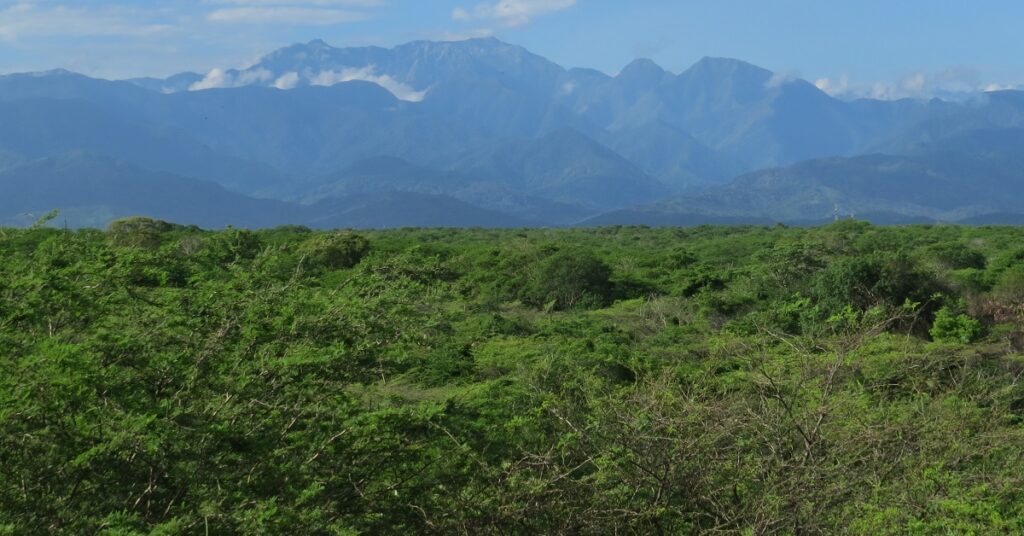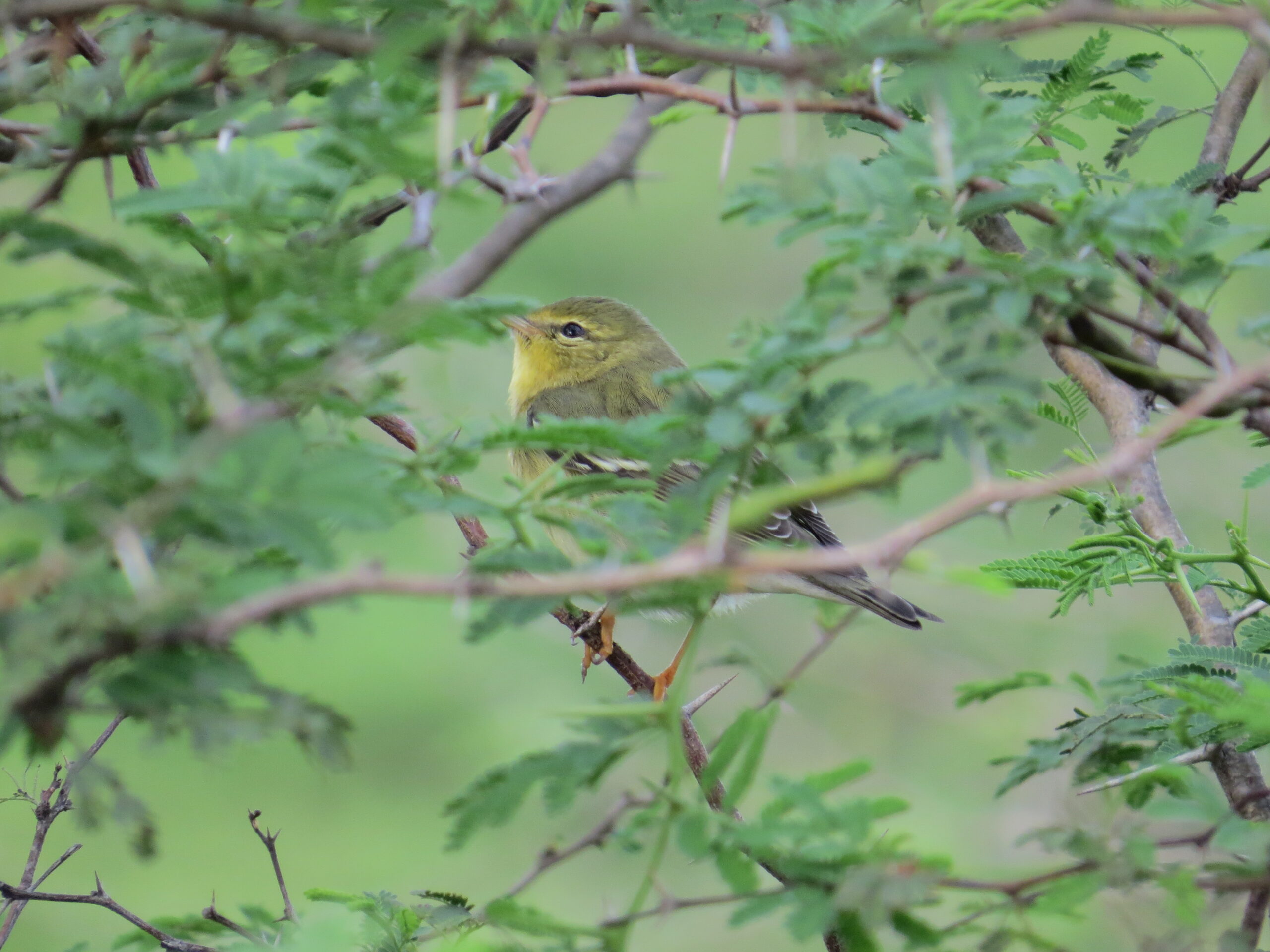By Nicholas J. Bayly
Linked paper: Rapid recovery by fat- and muscle-depleted Blackpoll Warblers following trans-oceanic migration is driven by time-minimization by Nicholas J. Bayly, Kenneth V. Rosenberg, D. Ryan Norris, Philip D. Taylor, and Keith A. Hobson. Ornithology.
For scientists and bird watchers alike, when we think about epic migratory journeys, the Blackpoll Warbler (Setophaga striata) is often a species that comes to mind. Every year in the fall, thousands of these medium-sized warblers stream across North America toward the Atlantic coast in preparation for an epic journey to South America. Gorging themselves on insects and fruit, these once slim and sleek warblers balloon into puffballs as they take in gram after gram of fat in preparation for the journey ahead. Around mid-October—unlike most of us—the birds eagerly await a cold front. As soon as it has passed, they launch themselves across the Atlantic riding the northerly winds southward to South America, a 2,500+ km journey they complete in a mind-boggling non-stop flight using the energy-rich fat stored on board. And there the story ends, or so we thought.
Remarkably, where Blackpoll Warblers touch down in South America and how they recover from trans-oceanic flights was largely unknown until recently but is described in our paper out last week in Ornithology. This research forms part of a joint initiative between Colombian NGO SELVA (where I currently work), the Cornell Lab of Ornithology, and Environment and Climate Change Canada, with the goal of identifying and describing Neotropical stopover sites under the banner of the Neotropical Flyways Project. To achieve this goal, I have been leading teams of Latin American birders and biologists across Colombia, Panama, Costa Rica, and Nicaragua over the past five years. It was back in the fall of 2016, while surveying multiple sites across the Caribbean coast of Colombia, that we discovered an extraordinary concentration of Blackpoll Warblers.

The Caribbean coast of Colombia is a diverse region, spanning humid lowland rainforests, tropical dry forests, mangrove forest, montane forest, and even snow-capped peaks in the towering Sierra Nevada de Santa Marta. In general, there is a precipitation gradient defined by high rainfall in the West and increasingly drier conditions as one heads east, culminating in the sandy deserts of the Guajira peninsula in far northeastern Colombia. Where birds make landfall along this coastline clearly has strong implications for the habitats and associated food resources they will encounter. As might be expected, most migrants concentrate in humid forests on arrival, but this was not the case for Blackpoll Warblers. Contrary to our expectations, we recorded close to 1,000 individuals in dry thorny Caribbean scrub on the Guajira peninsula and just a handful of birds elsewhere, despite the close proximity of humid forests.
So, what were birds doing in these habitats and what does this mean for recovery following demanding trans-oceanic flights? To answer this question, we returned to these sites in 2017 and 2018 and established a constant effort mist-netting station during the month of October. Over two years, we captured more than 1,200 Blackpoll Warblers but, importantly, we also recaptured 74 individuals; no mean feat when it comes to warblers on stopover. The first thing that struck us was the condition of birds on arrival. A significant percentage of birds were emaciated, lacking any visible sign of the huge fat reserves with which they departed North America and with knife-like flight muscles, indicative of protein burn during endurance flights. For anyone who has handled a healthy 11 or 12 g Blackpoll Warbler, seeing these gaunt birds weighing as little as 8.3 g is both distressing and humbling. Despite the extreme demands placed by trans-oceanic flights, the recaptures revealed a phenomenal capacity for rapid recovery.
On average, recaptured birds remained at our study site for seven days in 2017, and just three days in 2018; however, this was time enough for birds to rapidly rebuild their fat reserves. Indeed, most birds increased their body mass by between 1 and 2 g and departed with sufficient fuel to reach their wintering grounds. So how was this possible in a xeric habitat dominated by thorny acacias, devoid of fruit or any apparently high-quality food source? Our research suggests that the key to this whole migration system might be the precise timing of their arrival on the usually dry Guajira peninsula. Plants in the Guajira are considered ecologically dead for nine months of the year, i.e. they do not grow and do not produce new leaves. However, between September and November, a brief rainy season triggers a period of fervent leaf production and growth. The peak of the rainy season just happens to coincide with the arrival of Blackpoll Warblers in mid-October and also with the appearance of hordes of caterpillars munching on the fresh green leaves—perfect food for an exhausted and hungry Blackpoll Warbler.
Considered together, the short stops and rapid mass increases described above, suggest that evolution has selected for birds to spend as little time as possible at stopover sites in northern Colombia. For me, this was nothing less than unexpected, given the clear signs of physical exhaustion following non-stop flights. At the very least, I expected to find evidence for birds rebuilding their metabolic machinery or flight muscles after endurance flights but, instead, our findings are testament to the remarkable adaptations Blackpoll Warblers possess for long-distance migration.
